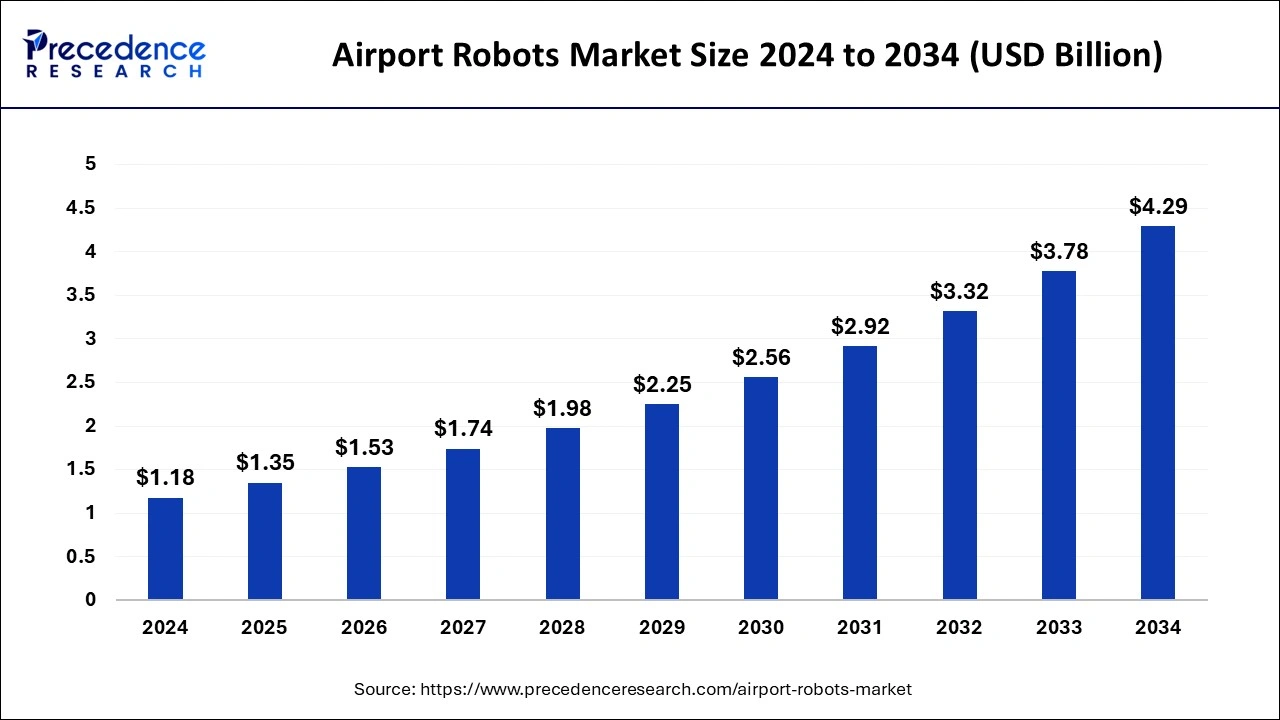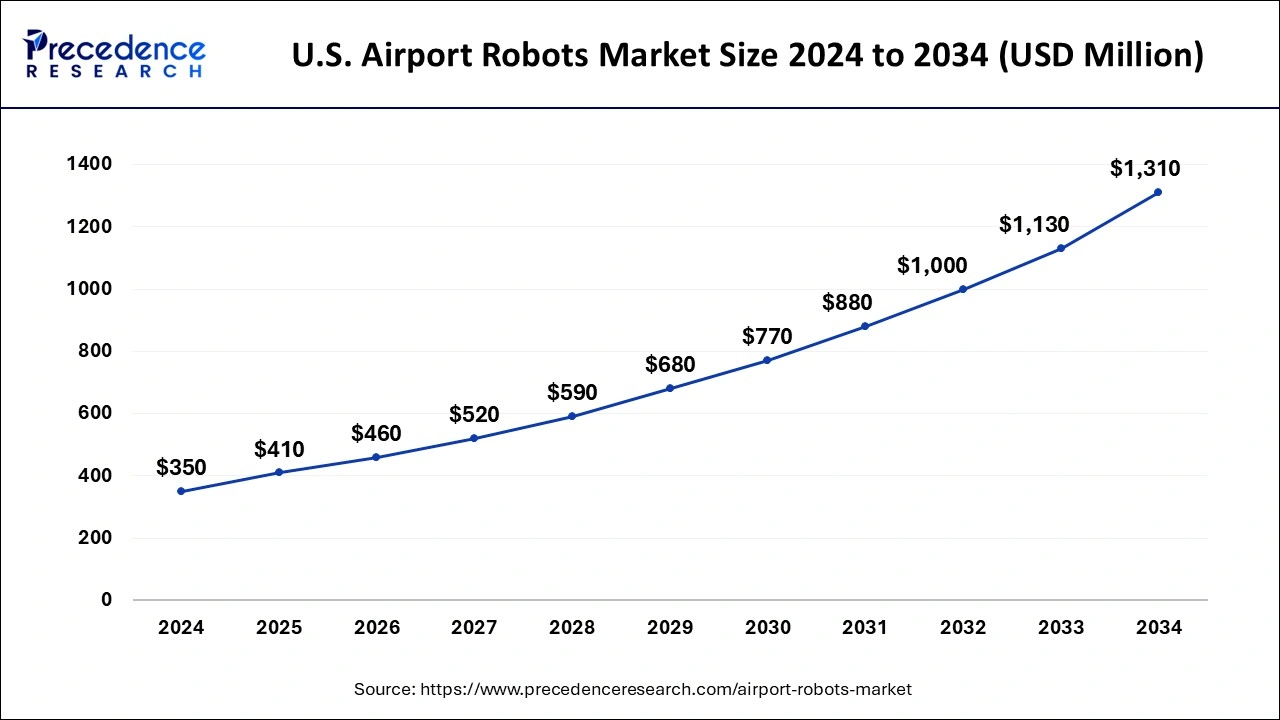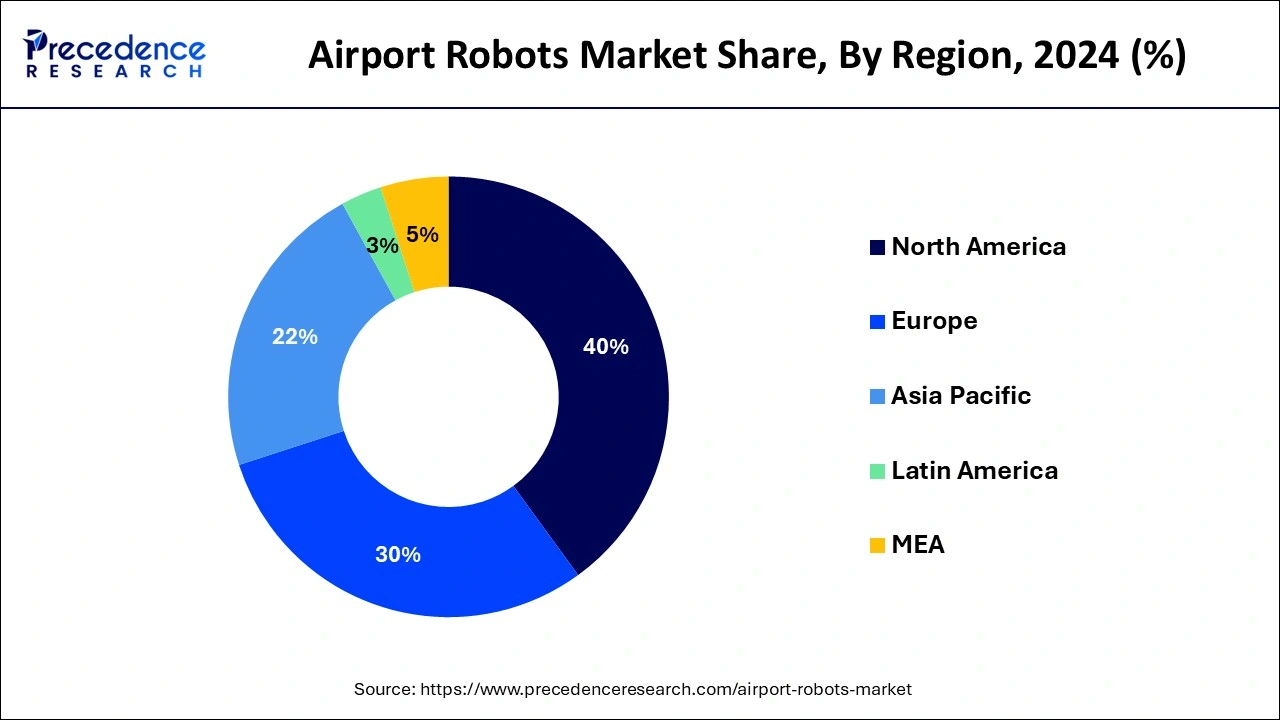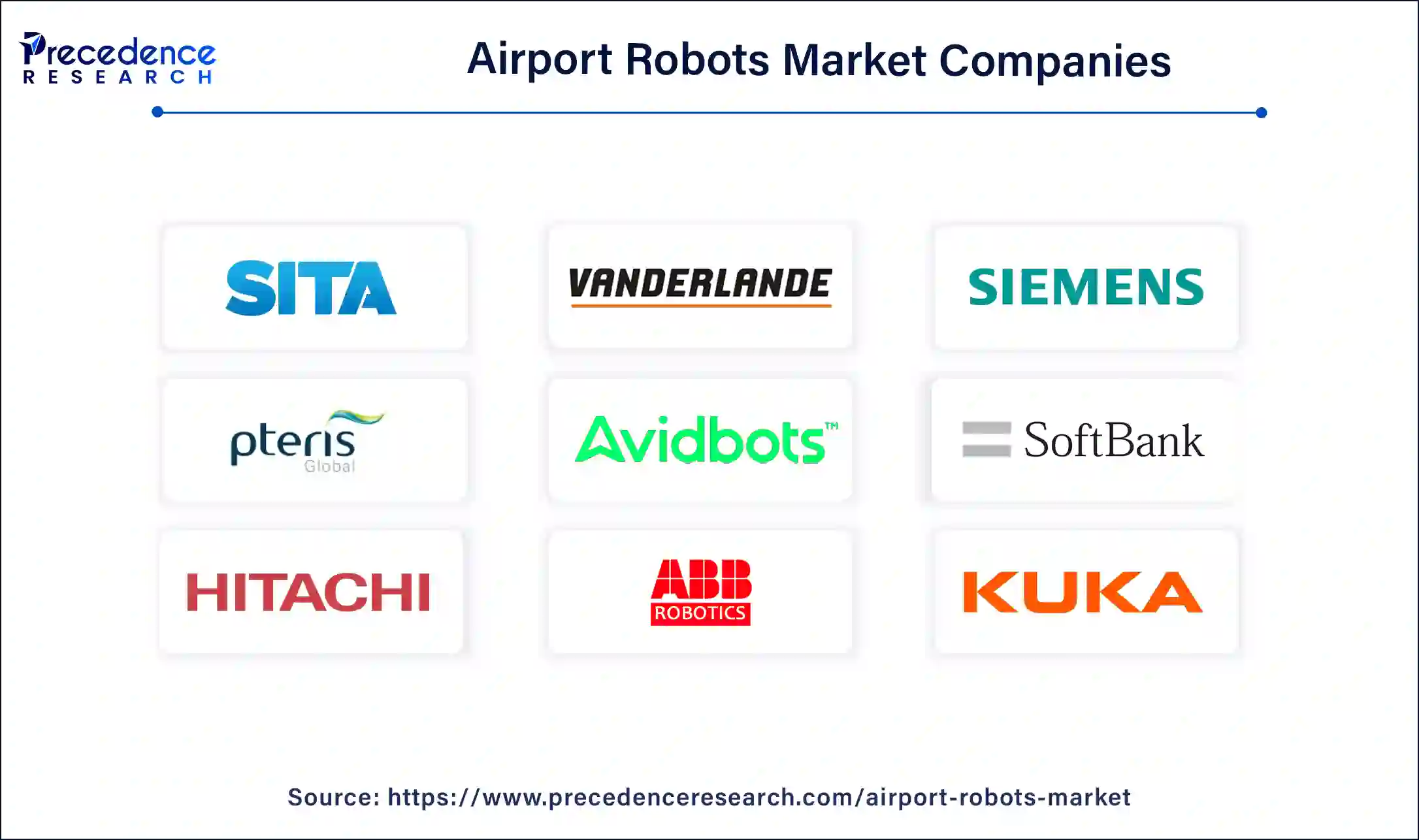November 2024
The global airport robots market size is accounted at USD 1.35 billion in 2025 and is forecasted to hit around USD 4.29 billion by 2034, representing a notable CAGR of 13.76% from 2025 to 2034. The Asia Pacific market size was estimated at USD 470 million in 2024 and is expanding at a CAGR of 13.98% during the forecast period. The market sizing and forecasts are revenue-based (USD Billion/Billion), with 2024 as the base year.
The global airport robots market size was calculated at USD 1.18 billion in 2024 and is predicted to reach around USD 4.29 billion by 2034, expanding at a CAGR of 13.76% from 2025 to 2034. Robotic technology at airports offers efficient operations, streamlines processes, enhances security, and improves customer experience, which contributes to the growth of the airport robots market.

Airport robots are used for passengers' safety to carry out their health checks; with the help of built-in cameras, sensors, and algorithms, they have the ability to measure pulse rate and detect high body temperature, heart rate, and stress level. AI-powered robots enhance security procedures by performing tasks such as facial recognition and self-service check-ins. The airport robots market with artificial intelligence detects prohibited items that are restricted at airports, including knives, firearms, and ammunition at the security checkpoint.
The U.S. airport robots market size was exhibited at USD 350 million in 2024 and is expected to be worth around USD 1,310 million by 2034, growing at a CAGR of 14.10% from 2025 to 2034.

North America dominated the global airport robots market in 2024. The dominance of this region is due to the expanding research and development in robotics and the increasing adoption of robots at airports for passengers' safety, convenience, and better experience. A fully autonomous delivery robot is commonly seen at airports in North America, and it is used for delivering food, beverages, and lifestyle items within the airport premises. This initiative encourages ordering with contactless delivery. Another demand for robots in the United States is for airport security.

Asia Pacific is observed to host the fastest-growing airport robots market during the forecast period. The growth of this region is due to the adequate cleaning and disinfection facilities provided at Asia Pacific airports. Additionally, these robots are capable of cleaning canals and removing rainwater. The robots tailored for repetitive tasks ultimately enhance the operational efficiency within the airport terminal. COVID-19 has made a significant impact on maintaining sanitation at the airport premises. As airport authorities have deployed autonomous robots, there has been an impressive reduction in the spread of viruses and other infectious diseases.
Robotic systems are airports in a novel implementation, which has a crucial role to play in the construction and maintenance of the airport infrastructure. They are primarily used for staffing airport check-in desks, carrying out security protocols, cleaning and delivering food to passengers. With growing technological advancement and economic pressure, such as operational costs, airport robots embrace technology, which leads to reduced labor costs and improved profitability. The rising digital transformation at the airport is gaining momentum, converging existing systems with automation and robotics, which results in more efficiency, security, and passenger-centric performance.
| Report Coverage | Details |
| Market Size by 2024 | USD 1.18 Billion |
| Market Size in 2025 | USD 1.35 Billion |
| Market Size in 2034 | USD 4.29 Billion |
| Market Growth Rate from 2025 to 2034 | CAGR of 13.76% |
| Dominating Region | North America |
| Fastest Growing Region | Asia Pacific |
| Base Year | 2024 |
| Forecast Period | 2025 to 2034 |
| Segments Covered | Type, Application, End-user, and Regions |
| Regions Covered | North America, Europe, Asia-Pacific, Latin America, and Middle East & Africa |
Leverage Economy
The broad utility of robotics in various industries has shown a positive impact on the business and employees. The economy drives better productivity by investing in machines, computers, robotics, and other items that offer optimized output for the airport robots market. Economists anticipate that technological advancement toward robots and automation will significantly impact the labor market. Automation is expected to increase labor productivity, which will ultimately increase economic growth and create more jobs. Robots have the potential to reduce human-causing errors; the embedded sensors help detect potential problems, control processes, enhance safety, and ensure proper functioning. Moreover, it improves operational accuracy, increases productivity, and enhances worker safety.
Threatening Employment
There is no denying the fact that robotics is proving to be gradually dangerous for employees. Robots are replacing jobs significantly, and this is threatening low-skilled workers and middle-skilled professionals. The airport robots market has an adverse effect on employment due to its labor-saving nature.
Gaming and entertainment
The facility of gaming and entertainment for the passengers at the airport is expected to be witnessed in the coming future. In the airport robots market A robot can be used as a performer or complement human performers. Deep learning (DL) technology facilities in training robotics with interactive entertainment to identify and analyze main decision events in games.
With the help of image recognition, action analysis, and rule matching, a robot can monitor the real-time game process and act as a referee. The airport robots market products are bound to revolutionize the future of gaming and entertainment through the implementation of artificial intelligence, advanced robotics, and creative programming, which will expand its way to another level.
The non-humanoid segment generated the major share of the airport robots market in 2024. As non-humanoid robots increase productivity and safety while reducing labor costs, they contribute to the rising market growth. A non-humanoid robot is designed to do repetitive tasks at the airport, such as cleaning, self-driving the passengers, security checking, scanning boarding passes, and identifications. The non-humanoid robot is proven to improve the operation efficiency of the airport.
The humanoid segment is projected to expand rapidly in the airport robots market over the coming years. Humanoid robots are becoming useful in many countries with rising labor shortages. Humanoids are useful in reinventing work, including supporting and complementing workers. The future expansion of this segment is anticipated as humanoid robots are more or less designed to mimic humans, which can help passengers with personal assistance, caregiving, entertainment, search and rescue operations, healthcare, and many more.
The terminal segment captured the biggest airport robots market share in 2024. The dominance of this segment is credited to the requirement of a robot at the terminal to improve efficiency. The robot ensures the airport terminal is clean and frees up human staff for other important tasks. Several key players and specialists are using robots for runway maintenance and construction of terminal buildings. Some airports are facilitated with autonomous AI robots that help passengers with visible disabilities or immobility.
The landside segment will show significant growth in the airport robots market during the forecast period. The expansion of this segment is observed owing to the robots with the built-in features of biometric capabilities, which scan passenger identities for verification, enhance security, and reduce the waiting period. AI-powered robots in the car parking outside the airport, managing the parking, keeping a record of parking time, and easing the payment process.
The airport security segment contributed the highest share of the airport robots market in 2024. The dominance of this segment is noticed as an advanced robotic system enhances security by automating the screening process and maintaining stringent security standards and protocols. The security robots in the airport are embedded with high-definition cameras that feature facial recognition software that relays pictures to the security station for analysis. Some AI-based robots are equipped with software algorithms that use artificial intelligence to automatically detect items that are restricted at the airport.
The passenger guidance segment is expected to grow at the fastest CAGR in the airport robots market during the forecast period. The growth of this segment is expected as robots in airports are making it convenient, stress-free, and improving passenger experience. A robot scans the passengers' boarding passes and navigates them to their departure gate. A multi-lingual robot helps passenger with their queries in the desired language.

By Type
By Application
By End-user
By Geography
For inquiries regarding discounts, bulk purchases, or customization requests, please contact us at sales@precedenceresearch.com
No cookie-cutter, only authentic analysis – take the 1st step to become a Precedence Research client
November 2024
September 2023
October 2024
November 2024